|
||||||||||
|
|
||||||||||
|
||||||||||
|
|
||||||||||
The Hindenburg was the culmination of research into the rigid airship that had first been perfected by Count Ferdinand Graf von Zeppelin of Germany around 1900. Zeppelin founded his own company that built several successful airships through World War I. Because many of these zeppelins were used to conduct bombing raids on England and France during the War, the post-war peace treaties imposed by the Allies severely restricted future construction of these craft. The airship began to make a comeback during the mid-1920s, however, thanks to the leadership of Dr. Hugo Eckener who took over the Zeppelin company following Count Zeppelin's death. The company reached its peak during the early 1930s when the airship Graf Zeppelin demonstrated regular transatlantic passenger service was safe and practical. The Graf Zeppelin completed several record-setting flights including a circumnavigation of Earth in 1929, a flight over the Arctic in 1931, and appearances at numerous major world events. These successes lured a growing number of passengers and mail services to use the new airship line for transportation between Europe and the Americas.
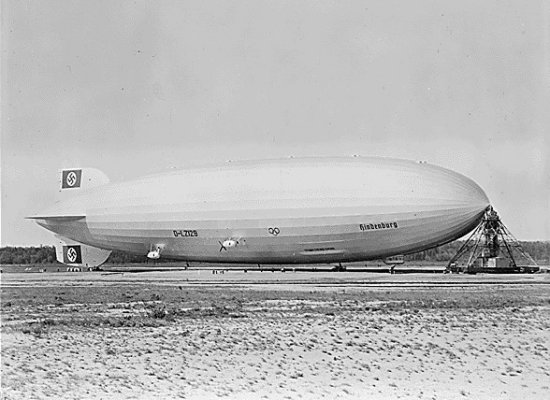
The popularity of the Zeppelin line prompted Eckener to build a second airship to the same design as the Graf Zeppelin. However, this model was cancelled following the crash of Great Britain's R.101 airship in 1930. The disastrous accident cost 48 lives and was blamed in part on hydrogen gas, used for lift, that had ignited as the airship came down. Eckener then decided to abandon hydrogen in his next airship, the Hindenburg, in favor of the inert gas helium. Unfortunately, the Nazis had come to power by the time the Hindenburg was completed in 1935 and the United States, which controlled the world supply of helium, refused to sell the gas to a German company. The Hindenburg was instead modified to use hydrogen for buoyant lift, and steps like special treatments to its skin coating were taken to avoid sparks that might ignite the gas. Despite these concerns, German airships had a long history of safe operation using hydrogen and no fire due to the gas had ever occurred on a civilian zeppelin. Indeed, no passenger had ever been injured on one of the German company's airships and the Graf Zeppelin had flown over 1 million miles (1.6 million km) without incident.
Upon its completion, the enormous Hindenburg measured 804 ft (245 m) in length with a diameter of 135 ft (41 m) and could lift a massive payload of 123.5 tons (112,000 kg). The great bulk of the vessel provided space for 16 cells containing over 7 million cubic feet (200,000 cubic meters) of lightweight gas to give the airship buoyancy. Powered by four 1,200 hp diesel engines that gave the ship a top speed of 85 mph (135 km/h), the Hindenburg carried a total of 72 passengers and 61 crew and was capable of making transatlantic voyages between Germany and the United States or Brazil.

The mighty Hindenburg began commercial flights in 1936 and successfully completed 17 round trips that year. Its journeys covered 191,583 miles (308,323 km) while carrying 2,798 passengers and 160 tons of cargo. This success led the Zeppelin company to begin construction of a twin vessel, the Graf Zeppelin II, and expand the flight schedule. Hindenburg's first flight of 1937 was a round trip to Brazil while the second was a round trip to Lakehurst, New Jersey, in the US. This flight departed Germany on 3 May 1937 carrying a smaller than normal load of just 36 passengers. In command of the vessel was Captain Max Pruss who steered Hindenburg on a smooth and uneventful journey across the Atlantic. The only difficulty encountered was strong headwinds that delayed the airship's arrival time from 6 AM to 4 PM on 6 May.
Steady rains had been falling on Lakehurst overnight and throughout the day, and thunderstorms with strong winds continued to worsen as the Hindenburg approached the area. Commander Charles Rosendahl, who was in charge of the Naval Air Station at Lakehurst, transmitted messages to Captain Pruss advising the Hindenburg to delay landing and remain in a circular flight pattern beyond the edge of the storm until the winds subsided. By 5 PM, 92 Navy and 139 civilian ground crew members were called into position for the landing attempt, but rain intensified until after 6 PM. At 6:12, the skies had cleared enough for Commander Rosendahl to inform Hindenburg, "Conditions now considered suitable for landing." Yet it was not until 7:10 that the airship was able to make its way back to the station and Commander Rosendahl again replied, "Conditions definitely improved recommend earliest possible landing."
The great Hindenburg circled over the field as Captain Pruss slowed the vessel and descended through the stormy cloud deck at 600 ft (180 m). As he moved his ship towards the mooring mast, Pruss made a sharp left turn and began dropping water ballast from the stern to lighten the tail. By 7:21, the Hindenburg was still some 300 ft (90 m) high and about 1,000 ft (305 m) away as the ship slowly closed in on the mooring mast.
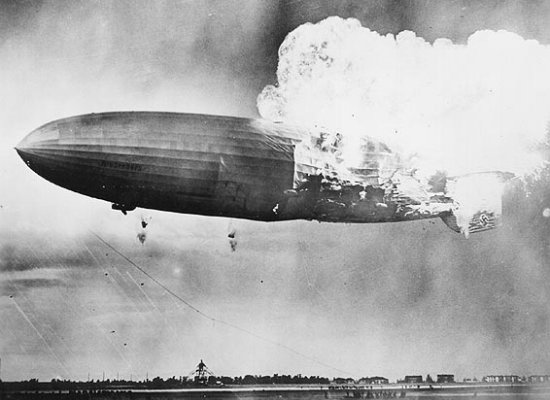
The first hint of impending disaster came just a few minutes later when Hindenburg crewman dropped their mooring lines from an altitude of 200 ft (60 m). At that moment of 7:25 PM, witnesses on the ground reported seeing a small flame rising from just in front of the top tail fin of the ship. Two crewman stationed near the lower tail fin both happened to be looking towards Gas Cell 4 when they noticed a sudden bright flash of light near the catwalk. The two also indicated they heard a small explosion, the sound reminding them of the burner on a stove being turned on. Almost immediately, the men were surrounded by an inferno as the airship ignited.
An explosive ball of fire quickly leapt into the sky and the entire tail was engulfed in flames within just five seconds. As the hydrogen from the aft cells was released, the Hindenburg's tail soon began plummeting and struck the ground as the fire rapidly spread forward consuming the center of the airship. Hindenburg was almost vertical as the fire raced forward along its outer skin to engulf the remainder of the ship. It took just 34 seconds for the entire vessel to be consumed by flames, leaving nothing behind but a collapsed and charred steel framework.

Amazingly, 62 of the 97 people aboard survived. The fatalities included 13 passengers and 22 crew plus one death among the Navy ground crew. The majority of the deaths were not from fire but were incurred by jumping from the ship while it was still several stories high. Since the fire occurred above most of the passengers and crew, those who remained aboard the ship during its relatively gentle descent to the ground escaped with minor injuries, for the most part. Among the survivors were Captain Pruss and both of the crewmen from the tail who had first observed the fire.
It was not long after the glowing hot metal had cooled when theories about the cause of the disaster began to emerge. Both the United States and Germany conducted investigations into the crash, and both concluded sabotage was a distinct possibility. One of the reasons favoring sabotage was that the Hindenburg was a powerful symbol of Nazi Germany and its destruction would damage Nazi prestige. Eric Spehl, a crewman aboard the vessel who died in the crash, was even named as the most likely saboteur. Spehl served as a rigger who was stationed near Gas Cell 4 where the fire that destroyed the ship is believed to have begun. Further evidence used against Spehl includes that his girlfriend was a suspected communist with anti-Nazi connections and the discovery of a dry-cell battery in the wreckage. Spehl was an amateur photographer acquainted with flashbulbs, and some theorize he used one of these bulbs powered by the battery as an ignition source to start the catastrophic fire.
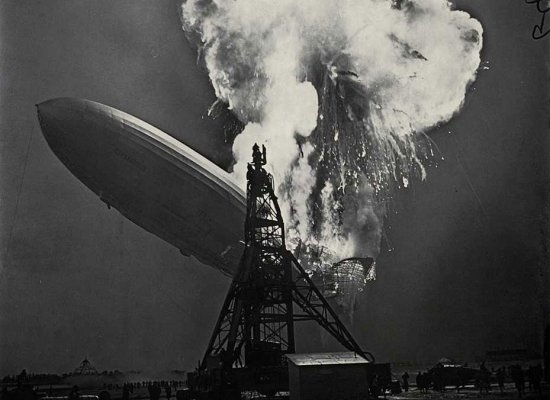
Nevertheless, the sabotage theory has been largely discounted given the lack of any firm evidence to support it. Most of the arguments favoring sabotage are based on conjecture and coincidence. For example, the testimony of the two crewmen who spotted the flash of light near Gas Cell 4 just prior to the fire has been used against Spehl since his duty station was along the catwalk near where the flash occurred. Furthermore, it is rumored Spehl was relieved of duty about an hour and a half before the explosion by the airship's chief rigger Ludwig Knorr. Knorr casually mentioned this news to a fellow crewman in passing, but the reason why he did so will never be known since Knorr was killed in the crash. Those who suspect sabotage conjecture Knorr may have noticed suspicious activity on Spehl's part, but this is pure speculation. Opponents counter that Spehl is merely an opportune scapegoat since he did not survive to defend his reputation. Indeed, the most ardent supporters of the sabotage theory were Captain Pruss and his family who may have been trying to deflect blame from the Captain's own actions in those final moments before disaster struck.
An alternate explanation, still considered the most likely, is called the static spark theory. This theory states static electricity built up on the outer skin of the Hindenburg and could not be dissipated. The accumulation caused a difference in charge to form between the airship and the ground. As the airship passed through the rainy weather over New Jersey, the mooring ropes dangling from it became wet and conductive. Once these wet mooring lines touched land, they grounded the airship's aluminum frame and may have allowed the excess electrical charge on the outer skin to jump to the internal framework. Evidence supporting this theory includes eyewitnesses who reported observing a bright glow along the tail section of the airship consistent with the ionization of air caused by a strong electrical field.

Dr. Hugo Eckener, meanwhile, believed a hydrogen leak was responsible for the crash. Although releasing hydrogen in inclement weather was prohibited because of extreme fire danger, this safety rule may have been violated on purpose or on accident as Captain Pruss rushed to make a landing. One specific possibility is called the puncture theory. Eckener speculated the Hindenburg's sharp turn shortly before landing could have produced high tension in the aft structure of the airship. This tension strained the wires holding the tail fins in place and could have been large enough to cause one or more of those wires to break. The snapping wire might have then punctured one of the gas cells and caused leaking hydrogen to escape. Any small spark, like the grounding discharge mentioned earlier, ignited the gas and started the great conflagration that doomed Hindenburg. The only solid evidence supporting this theory is gauges found in the wreckage indicating tension in wires at the rear of the airship was far higher than normal, but these high tensions may have been a result of the crash rather than the cause of it.
A related theory stated a structural or mechanical failure might have caused the disaster, but this explanation was ruled out after engineers found no evidence to support it. Also eliminated was suspicion of a problem with Hindenburg's electrical system since no electrical faults were observed throughout the journey across the Atlantic. A final possibility was a lightning strike, but Captain Pruss stated the airship had traveled through many thunderstorms before and been struck by lightning several times without incident.
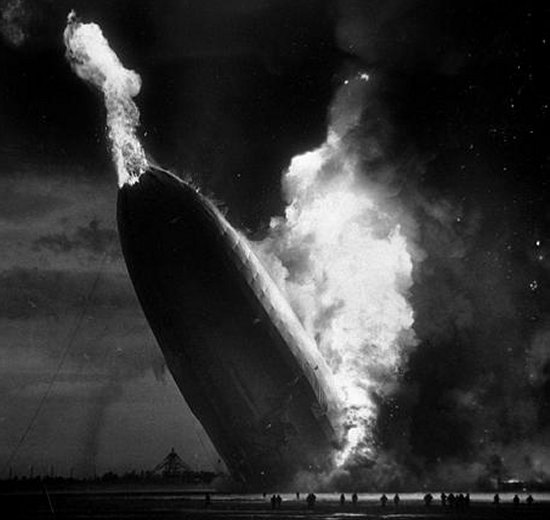
Another avenue that has intrigued investigators is the Hindenburg's skin. This subject is of particular interest to a former NASA employee named Addison Bain who believes the hydrogen gas aboard the airship is not to blame for the cause of the fire or its rapid spread. He instead believes the outer skin of the airship first ignited and the hydrogen would never have burned if the skin hadn't already done so. This flammable fabric theory is based on the Hindenburg's skin coating that consisted of iron oxide and aluminum-impregnated cellulose acetate butyrate dope. The doping material is known to be a flammable substance, and iron oxide also energetically reacts with aluminum powder. Since iron oxide is mixed with aluminum to create the explosive substance thermite and aluminum powder is often used to boost the performance of solid rocket motors, proponents of the flammable fabric theory frequently exaggerate by stating the Hindenburg was "coated in rocket fuel."
Evidence supporting the fabric theory is the Hindenburg remaining in level flight for several seconds after the fire began. If one of the hydrogen cells had ruptured due to a gas fire, supporters of the theory argue the ship would have started to tilt towards the ground almost immediately. If the fire were constrained to the skin, however, the cells would have remained intact much longer and kept Hindenburg airborne. Proponents also suggest Zeppelin engineers realized the danger of the skin coating after the disaster and secretly changed its composition on the Graf Zeppelin II. The new coating was said to include a fireproofing agent plus the aluminum was replaced with the less combustible metal bronze.
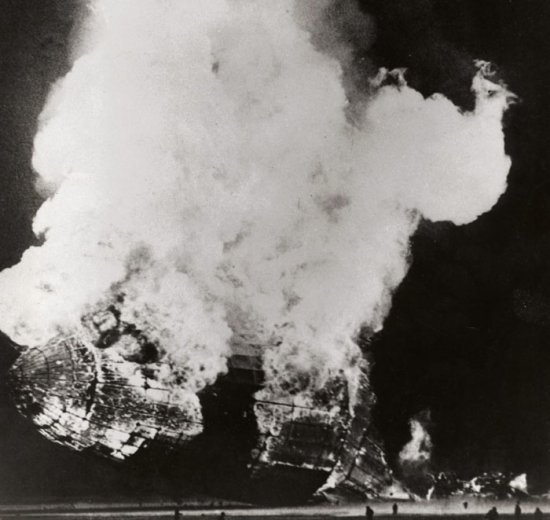
Nevertheless, more recent research conducted at the University of Colorado has contradicted this theory and found the airship's skin could not have been responsible for the fire's rapid spread. This theoretical and experimental research suggests that even if Hindenburg had been coated in actual solid rocket fuel, it would have taken at least 12 hours to burn in the absence of hydrogen. Experiments with recreations of the ship's skin have also found it would have taken some 40 hours for the Hindenburg to be consumed if the fabric had caused the fire. These finding led the researchers to conclude that although the Hindenburg's skin was combustible, it was not flammable.
Given the inability of investigators to conclusively determine why the Hindenburg crashed, it is not surprising so many theories to explain its destruction have emerged. Even so, the static spark theory is still considered the most likely since it is the best corroborated by the wreckage, video and photo evidence, and eyewitness reports. This evidence and academic research also supports the belief that the ship's hydrogen gas was ignited by static discharge and not the skin. The hydrogen burned explosively and rapidly spread the flames forward throughout the ship, and the skin only burned as a result of this intense fire.
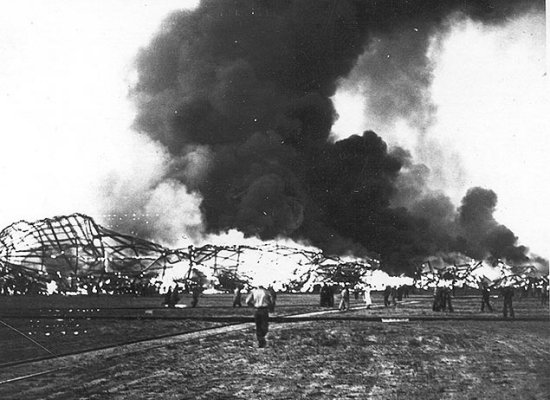
Regardless of the exact cause of the disaster, its impact on airship travel is without doubt. The fiery demise of the Hindenburg was widely covered by print and radio journalists while photos and video of the crash quickly spread around the world. These graphic portrayals of the crash immediately doomed the future of zeppelins and no rigid airship ever carried commercial passengers again. By the time Graf Zeppelin II was completed in 1938, the clouds of war hung over Europe and the vessel was soon taken over by the Luftwaffe for military use. The ship completed just 30 flights by August 1939 when war finally erupted, but such a vehicle had no future in Nazi Germany.
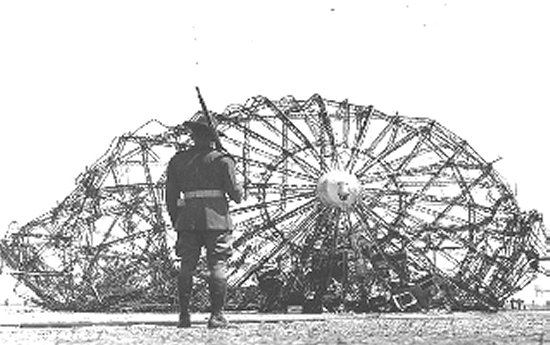
Needing
raw materials for new airplanes, head of the Luftwaffe Hermann Göring ordered the Graf Zeppelin II, the earlier
Graf Zeppelin, and the incomplete structure of another airship under construction to be scrapped and melted down.
The dismantling was complete by April 27, and the giant hangars that had housed the mighty airships were leveled on
May 6, exactly three years to the day after Hindenburg's destruction marked the beginning of the end of the rigid
airship.
- answer by Joe Yoon, 18 June 2006
Read More Articles:


|
Aircraft | Design | Ask Us | Shop | Search |

|
|
| About Us | Contact Us | Copyright © 1997- | |||
|
|
|||